Český Krumlov – UNESCO Site
By Tracy A. Burns
Many say that, after Prague, the southern Bohemian town of Český Krumlov is the most beautiful in the country. The narrow, romantic streets and richly decorated Renaissance facades certainly attest to the town’s charm. Take the buildings, for instance: one façade is adorned with alchemist symbols, another with sgraffito, and a third with 14th-century Gothic murals. The main square, The Square of Concord, features rows of Gothic and Renaissance houses, a town hall with four coat-of-arms on its façade and a Plague Column adorned with awe-inspiring statuary.
Český Krumlov Castle and Chateau
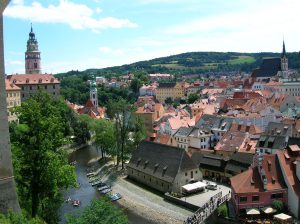 However, the highlight of the town is the Český Krumlov castle and chateau, the second largest castle complex in the country after Prague Castle, with its five courtyards and 11 hectares of gardens. On the UNESCO world heritage and natural heritage list, the complex offers two tours of the chateau and a third of the Baroque theatre.
However, the highlight of the town is the Český Krumlov castle and chateau, the second largest castle complex in the country after Prague Castle, with its five courtyards and 11 hectares of gardens. On the UNESCO world heritage and natural heritage list, the complex offers two tours of the chateau and a third of the Baroque theatre.
Built by the Lords of Krumlov, the Hrádek or “little castle” in Český Krumlov dates back to before 1250. The Rožmberks, with the five-petalled red, rose on their coat-of-arms, came in 1302 and stayed until the clan died out in 1602. During their 300-year reign, the chateau got a Renaissance makeover. After the Rožmberks, the chateau came into the hands of Habsburg Emperor Rudolf II, and his mentally ill son, Don Julius d’Austria, called the chateau home from 1605 to 1608. During his tenure there, he murdered the barber’s daughter, Markétka. (A painting of the murder can be seen on the route I chateau tour.) The Eggenbergs was next to arrive, living there from 1622 to 1719. Culture thrived here under the rule of Jan Kristián of Eggenberg. The Schwarzenberg family obtained the chateau in 1719 and held onto it until the complex was nationalized in 1947. It was Duke Josef Adam of Schwarzenberg who transformed the chateau into Rococo style.
The Chapel of Saint George starts off the route I tour with a flourish. Originally built in Gothic style, it was transformed into Rococo in 1753. A white statue of King George fighting a dragon is set above the 19th-century center altarpiece featuring the Virgin Mary and child. There are two side altars as well, and the walls are creamy artificial marble. The organ, situated to the right of the main altar, hails from 1750 and still works.
The fin de siécle of the route I tour is the lively, brightly colored Masquerade Hall, painted in Rococo style in 1748. This former ballroom and theatre space features murals of 135 people at a carnival: there are Chinese, Turks, Moors, and Commedia dell’arte personalities such as The Doctor and The Harlequin. Two painted life-size guards donning furry hats stand at attention at the entrance to the room. Even the artist and his assistant have added their self-portraits to niches. The figures have shadows as well. Look for the man falling over the theatre balcony or the half-man/ half-woman. One figure, dressed in red with a black hat, has a huge head and a diminutive body as if looking through a distorting mirror at an amusement park. Numerous glass chandeliers adorn the space.
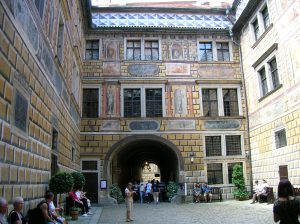 A painting depicting a significant legend hangs in one hallway. “The Division of the Rose” shows the Wittigons, then the owners of the Český Krumlov chateau, dividing their property among their five sons. Each man receives a coat-of-arms sporting a five-petalled rose in a different color. The Rožmberk soldier dressed in golden armor sports a red five-petalled rose, which would become a symbol of the chateau and town. Such a rose can be viewed in the antechamber, for instance, where guests once waited under a wooden, coffered, painted Renaissance ceiling decorated with red five-petalled roses on each panel.
A painting depicting a significant legend hangs in one hallway. “The Division of the Rose” shows the Wittigons, then the owners of the Český Krumlov chateau, dividing their property among their five sons. Each man receives a coat-of-arms sporting a five-petalled rose in a different color. The Rožmberk soldier dressed in golden armor sports a red five-petalled rose, which would become a symbol of the chateau and town. Such a rose can be viewed in the antechamber, for instance, where guests once waited under a wooden, coffered, painted Renaissance ceiling decorated with red five-petalled roses on each panel.
Another highlight of the tour is the gold carriage dominating the Eggenberg Hall, dedicated to the Eggenberg clan that owned the castle for almost 100 years in the 17th and 18th centuries. The carriage is decorated in gold and carved out of nut wood. Notice the female figure in a sea shell and the ornate wheels. The carriage was constructed in Rome in 1638 for the occasion when Johann Anton von Eggenberg was announcing to Pope Urban VIII that Ferdinand III had been chosen, emperor. Presents for the Pope filled the carriage as it traveled a few kilometers from Rome to the Vatican.
The route II tour concentrates on the 19th century when the Schwarzenberg clan lived there. Portraits of Schwarzenberg family members from the 14th century to 1918 adorn one room. Notice the portraits of Joseph Adam, who renovated the chateau in Rococo style. A marble bust depicts Frederick, archbishop of Prague and later Cardinal. Felix von Schwarzenberg, who served as Prime Minister of Austria from 1848 to 1852, can be seen here, too. The Gentleman’s Room boasts 114 English etchings of the romantic landscape while the Music Salon features a 19th-century Viennese piano that still works.
The Schwarzenbergs owned 87 Dutch and Flemish tapestries, some of which are sprinkled throughout the rooms. The family’s coat-of-arms, dominated by a Turk’s head to celebrate a victory over the Turks and also adorned with white and blue stripes, is also often visible. In one room a tapestry features the clan’s coat-of-arms. In the bedroom of the princess, Dutch tapestries dating from 1620 to 1630 tell the tale of Aeneas, a main player in the Trojan Wars. A portrait gallery shows off the artwork by German, Italian, Dutch and Flemish masters, such as “The Adoration of the Magi” by Paolo Veronese and “The Holy Family” by Peter Paul Rubens. Yet another depicts the fire of Troy, but the painter has added a Gothic cathedral to his rendition. Baroque maps line the Cloak Passage.
The Baroque Theatre
That is not all the castle complex has to offer. The Baroque theatre is one of the oldest Baroque theatres in Central Europe and one of the best-preserved Baroque theatres in the world. Theatre in Český Krumlov has a long, rich tradition, going back to the 15th century. This theatre was built in 1682 by Johann Kristián von Eggenberg and then restored in 1766 by Josef Adam von Schwarzenberg. In 1898 it was closed, only to occasionally be used for festivals in the 1950s and 1960s. In 1966 it was closed again and did not reopen until 1997. Nowadays, performances take place here several times a year, with actors wearing Baroque attire. There are 13 basic sets, such as those depicting a forest, military camp, and prison. The set of the temple features flying putti suspended blue clouds and spiraled columns reaching into the horizon. Fifty special effect machines have been preserved. Turning a lever of one machine produces the sound of the wind. Pushing another machine makes the rumble of thunder. Under the stage the visitor sees how scenery changes were made within eight to 12 seconds, incorporating winches, pulleys, and ropes that were attached to the side wings. The inventory also includes 573 original costumes and 2,400 props, stage, and lighting equipment. Sixty percent of stage machinery functions today.
The Chateau Park
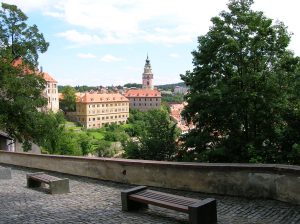 Don’t miss the chateau’s Baroque park with ornate statuary decorating its 18th-century, four-tiered, cascade fountain, Neptune perched at the top. Twenty decorated vases also adorn the park. A revolving auditorium is used for performances in the summer and the Bellaire summerhouse is also on the grounds. Straight out of a Claude Monet painting, a pond covered in water lilies is another attraction.
Don’t miss the chateau’s Baroque park with ornate statuary decorating its 18th-century, four-tiered, cascade fountain, Neptune perched at the top. Twenty decorated vases also adorn the park. A revolving auditorium is used for performances in the summer and the Bellaire summerhouse is also on the grounds. Straight out of a Claude Monet painting, a pond covered in water lilies is another attraction.
Other Places to Visit at the Castle
On the castle grounds, it is also possible to climb the tower with the brightly decorated Renaissance facade, visit a lapidary, see art exhibitions, and to gaze at the bears in the moat. The New Burgrave’s House, now housing the library, boasts murals created with the chiaroscuro technique.
Museums in Český Krumlov
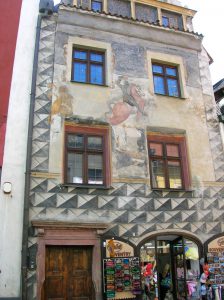 Museums dot the small town, including the Egon Schiele Art Centrum and the Regional Museum. The painter Schiele moved to Český Krumlov in 1911 but soon had to leave because the town society did not approve of his liberated lifestyle, which involved using young females as nude models. Furniture from his estate, some of which he designed himself, is on display as is his artwork, including his angular, dynamic renditions of the town.
Museums dot the small town, including the Egon Schiele Art Centrum and the Regional Museum. The painter Schiele moved to Český Krumlov in 1911 but soon had to leave because the town society did not approve of his liberated lifestyle, which involved using young females as nude models. Furniture from his estate, some of which he designed himself, is on display as is his artwork, including his angular, dynamic renditions of the town.
The Regional Museum fascinates with its exhibition of Czechoslovak history. While it focuses on Český Krumlov’s past, the exposition also gives a solid overview of the country’s history as a whole. The most noteworthy section covers the 20th century, which examines how World War II and its aftermath affected the town. The exhibition explains how the Nazis were greeted enthusiastically in 1938 by the thousands of German-speaking Sudeten Germans who lived in Český Krumlov. The town was incorporated into the Third Reich that same year. On display are pictures of Fuhrer Adolf Hitler visiting the town, accepting flowers from a young girl, inspecting soldiers, and riding in a jeep. The Sudeten Germans that inhabited the town during the Third Reich were sent to refugee camps after the war and expelled from the country, as put forth in the Beneš decrees, drawn up by second democratic republic President Edvard Beneš. (The controversial decrees still apply today.) One gripping photo shows the US army in Český Krumlov in May of 1945, just as the US troops were pulling out and handing the town over to the Soviets. Other objects on display include a large bust of first Communist president Klement Gottwald plus posters and advertisements preaching Communist propaganda, such as one sign explicitly denouncing then US president Ronald Reagan. The museum has, even more, to offer, however. On the top floor, there is furniture and artwork from various eras, such as some Late Gothic pieces and exquisitely carved Renaissance furniture as well as a model of the town and a Baroque pharmacy.
The Former Jesuit Seminary, Now the Hotel Růže
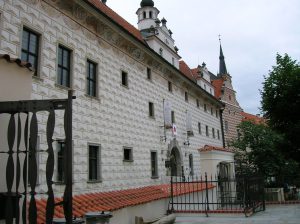 Across the street from the Regional Museum is the posh Hotel Růže, a former Jesuit seminary founded in the 17th century. In the foyer, guests get a history lesson as a picture of Hitler in the town and another of American troops leaving hang on one wall along with a painting and plaque of first democratic Czechoslovak President Tomáš Garrigue Masaryk. A plaque to Edvard Beneš hangs there, too. Beneš’s tenure as president remains controversial. Though opposed to a Nazi takeover of the Sudetenland, he signed the Munich Agreement, which gave the Germans the right to do exactly that. At the entrance to the hotel are statues of Masaryk and Beneš. A picture in the hallway shows current President Václav Klaus laying flowers at the foot of the statues.
Across the street from the Regional Museum is the posh Hotel Růže, a former Jesuit seminary founded in the 17th century. In the foyer, guests get a history lesson as a picture of Hitler in the town and another of American troops leaving hang on one wall along with a painting and plaque of first democratic Czechoslovak President Tomáš Garrigue Masaryk. A plaque to Edvard Beneš hangs there, too. Beneš’s tenure as president remains controversial. Though opposed to a Nazi takeover of the Sudetenland, he signed the Munich Agreement, which gave the Germans the right to do exactly that. At the entrance to the hotel are statues of Masaryk and Beneš. A picture in the hallway shows current President Václav Klaus laying flowers at the foot of the statues.
You Cannot Go Wrong in Český Krumlov
There are numerous ways to spend one’s time in Český Krumlov. Cycling and boating are two other options. Whatever visitors decide to do – stroll down its picturesque streets and gaze at its Renaissance facades, visit the spectacular castle and park or go to museums, the magic of the town is sure to cast a spell on everyone.



